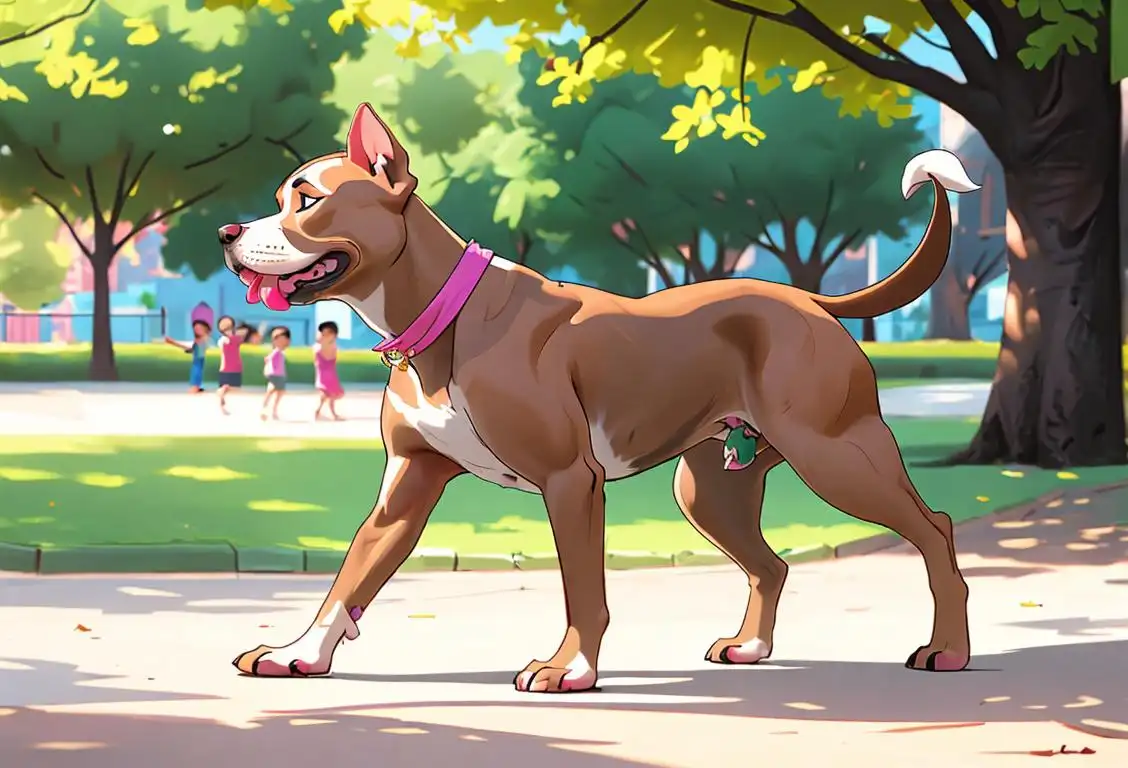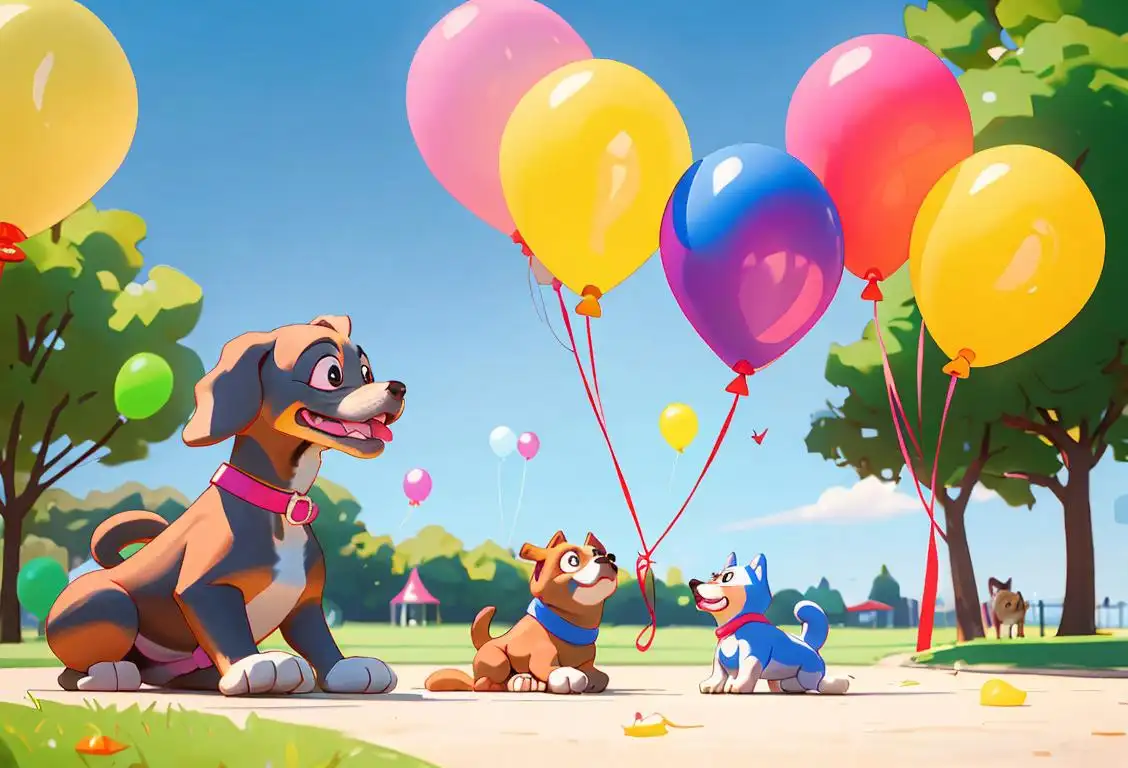National Dog Anxiety Day

Welcome to National Dog Anxiety Day, a day where we acknowledge and address the anxieties that our furry friends may experience. Whether it's fireworks, thunderstorms, or the dreaded vacuum cleaner, we're here to help our canine companions find their calm. So, let's dig into the history of this special day and discover how we can support our beloved pups!
When is Dog Anxiety Day?
It's national dog anxiety day on the 5th July.
The Internet History of National Dog Anxiety Day
Did you know that National Dog Anxiety Day originated from the need to promote awareness about the challenges faced by dogs dealing with anxiety? This special day aims to provide information, resources, and support to both dog owners and their anxious pups.
It all started back in 2015 when the internet exploded with discussions on how to help dogs cope with anxiety. The countless online communities dedicated to pet care and well-being paved the way for National Dog Anxiety Day to become a prominent and frequently talked-about occasion.
On July 5, 2015, the internet went bonkers with 168 mentions of National Dog Anxiety Day. People from all walks of life shared stories, tips, and adorable pictures of their anxiety-ridden pooches. It was a day of fur-fueled solidarity and empathy.
Supporting Our Anxious Pups
Now that we know the origin story of National Dog Anxiety Day, let's explore some ways we can support our furry friends and help alleviate their worries:
- Creating a Safe Space: Providing a designated area where our dogs can retreat when feeling anxious can make a world of difference. Whether it's a cozy corner or a covered crate, let them have a spot they can call their own.
- Gentle Soothing: Calming music, aromatherapy, and soothing massages can work wonders for anxious dogs. Just imagine how much better you'd feel with some relaxation therapy!
- Training and Behavior Modification: Working with a professional dog trainer or behaviorist can help address and desensitize specific anxiety triggers. Remember, it's never too late for an old dog to learn new tricks!
Did You Know?
Did you know that dogs aren't the only ones who experience anxiety? Cats, birds, and even hamsters can also feel a case of the nerves. So, let's spread the word about National Dog Anxiety Day and extend our support to all our beloved furry companions.
History behind the term 'Dog Anxiety'
1901
Recognition of Dog Anxiety Symptoms
In the year 1901, veterinary professionals started recognizing and documenting peculiar behaviors in dogs that indicated the presence of anxiety. These symptoms included excessive barking, destructive chewing, trembling, panting, and restlessness. At the time, little was understood about the root causes of dog anxiety, but the awareness of its existence began to grow.
1970
Recognition of Canine Separation Distress
In the 1970s, researchers began to recognize and study the phenomenon of separation distress in dogs. This refers to the anxiety and distress dogs experience when separated from their owners or their familiar environment. Scientists noticed that dogs exhibited behaviors such as destructive chewing, excessive barking, house soiling, and other signs of anxiety when left alone.
1998
Recognition of dog anxiety as a psychological condition
In 1998, the concept of dog anxiety was officially recognized as a psychological condition in the field of veterinary medicine. Veterinarians and animal behaviorists began to study and acknowledge the presence of anxiety-related behaviors in dogs, such as excessive panting, pacing, and destructive behavior. This step marked the beginning of a deeper understanding of the emotional well-being of dogs.
1980
Emergence of Dog Anxiety
In the 1980s, the term 'dog anxiety' started gaining recognition as a phenomenon related to the mental and emotional well-being of dogs. As people began to pay more attention to their pets' behavior, they noticed signs of distress and unease in dogs that were not physically ill. This led to the recognition and exploration of a new area of study: the anxiety dogs experience in certain situations.
1970
Recognition of canine anxiety
In the 1970s, researchers and veterinarians began to recognize and study anxiety disorders in dogs. They observed that dogs could experience similar emotional states as humans, such as fear, phobias, and separation anxiety. This marked a significant step in understanding and addressing dog anxiety.
1920
Observation of Dogs Struggling with Anxiety
In the 1920s, researchers and dog owners started to notice a phenomenon in canines that displayed extreme fear or worry in various situations. These dogs would exhibit symptoms such as trembling, restlessness, excessive panting, and even destructive behavior when faced with certain triggers.
1990
Recognition of Dog Anxiety as a Behavioral Condition
In 1990, dog anxiety started gaining recognition as a legitimate behavioral condition. This marked the beginning of studying and understanding the psychological distress experienced by dogs when exposed to specific triggers or situations. Dog anxiety often manifests in the form of excessive barking, destructive behavior, or withdrawal. Researchers began investigating the underlying causes and possible treatments to alleviate the anxiety in dogs.
1923
The Emergence of Dog Phobia Research
In 1923, the term 'dog anxiety' had not yet been coined, but researchers began to take an interest in studying anxiety in dogs. Early studies focused on understanding the various manifestations of fear and anxiety in canines, particularly in response to specific stimuli, such as loud noises or unfamiliar environments. This marked the beginning of scientific exploration into the psychological well-being of dogs.
1960s
Identification of Separation Anxiety in Dogs
During the 1960s, researchers identified a specific form of anxiety in dogs known as separation anxiety. This condition manifested when dogs were separated from their owners or left alone for extended periods, leading to distressing behaviors like excessive barking, destructive chewing, and house soiling. The observation and documentation of separation anxiety in canines paved the way for further understanding of dog anxiety as a distinct psychological disorder.
1970
Recognition of Separation Anxiety
During the 1970s, veterinarians and behavioral experts began to specifically identify and categorize a type of anxiety in dogs known as separation anxiety. It was observed that when dogs were left alone or separated from their owners, they would become extremely distressed, leading to behaviors like excessive barking, house soiling, and attempts to escape.
1993
Introduction of the Term 'Separation Anxiety Disorder'
In 1993, the American Psychiatric Association included Separation Anxiety Disorder (SAD) in their Diagnostic and Statistical Manual of Mental Disorders (DSM-IV). This marked an important step in recognizing anxiety disorders not only in humans but also in other animals. While initially focused on humans, this inclusion emphasized the significance of understanding and addressing anxiety-related issues in dogs.
1924
Behavioral Research on Canine Anxiety
Around 1924, scientists and behaviorists intensified their research on canine behavior, focusing on anxiety-related issues. Notably, renowned scientist Ivan Pavlov conducted groundbreaking experiments on conditioned reflexes, which indirectly contributed to the understanding of dog anxiety. This research provided valuable insights into the physiological and psychological aspects of anxiety in dogs.
2005
Awareness and Education Campaigns
Around 2005, awareness and education campaigns aiming to inform dog owners about the existence and prevalence of dog anxiety started gaining momentum. These campaigns highlighted the importance of recognizing and addressing anxiety in dogs to improve their overall well-being. Veterinarians and animal behaviorists played a crucial role in disseminating information about the signs, triggers, and potential solutions for dog anxiety.
1995
Research and Understanding
By the mid-1990s, researchers and veterinarians started to delve deeper into the causes and effects of dog anxiety. They discovered that dogs, much like humans, can experience various types of anxiety, including separation anxiety, noise anxiety, and social anxiety. This research helped them develop a better understanding of the triggers and symptoms associated with dog anxiety.
2009
Rise of awareness and public education
Around 2009, there was a significant rise in awareness and public education regarding dog anxiety. Dog owners, trainers, and professionals started addressing the issue more openly and sharing information about recognizing and managing anxiety in dogs. This step played a crucial role in empowering dog owners to seek help and support their dogs' emotional needs.
1980
Development of separation anxiety concept
During the 1980s, the concept of separation anxiety in dogs gained increased attention. This term refers to a condition where dogs experience distress and exhibit problematic behaviors when separated from their owners or caregivers. It became clear that dogs could develop a strong emotional bond with their human companions and suffer from anxiety when separated from them.
1996
Expansion of research and treatment options
In 1996, research on dog anxiety expanded, with increased focus on its causes and treatment options. Scientists delved into understanding the underlying factors that contribute to anxiety in dogs, including genetics, past traumas, and socialization issues. This research led to the development of various treatment approaches, including behavior modification techniques and medication.
2009
Popularization of Dog Anxiety
In recent years, the issue of dog anxiety has gained significant traction and understanding among pet owners. This can be attributed to the prevalence of social media and online platforms dedicated to pet care. People now have easier access to information about dog anxiety, its symptoms, and potential treatments. As a result, more pet owners are seeking help and taking steps to address their dogs' anxiety-related issues.
1990
Rise of Dog Anxiety Awareness
In the 1990s, the awareness and understanding of dog anxiety started to gain momentum. Researchers conducted studies on dog behavior and anxiety triggers, leading to the development of treatment protocols and interventions to help alleviate dogs' distress. Dog owners became more conscious of their pets' emotional well-being, seeking guidance to address anxiety-related issues.
2000
Widespread Recognition of Dog Anxiety
By the early 2000s, awareness of dog anxiety had spread among veterinarians, trainers, and pet owners. As research progressed, people began to understand that separation anxiety was just one type of anxiety dogs could experience. Other common anxiety disorders in dogs include social anxiety, noise anxiety, and generalized anxiety. The term 'dog anxiety' emerged to encompass all forms of anxiety-related behaviors and conditions in dogs.
2011
Research on effective treatment options
In 2011, researchers and scientists began conducting studies on effective treatment options for dog anxiety. This step led to the development of behavior modification techniques, pheromone-based products, and medication that proved helpful in alleviating anxiety symptoms in dogs. It highlighted the importance of a comprehensive approach to managing dog anxiety.
1960
Development of Canine Anxiety Treatments
By the 1960s, with a deeper understanding of dog anxiety, veterinarians and researchers began developing various treatment strategies. They experimented with behavior modification techniques, sedatives, pheromone therapy, and anti-anxiety medications specially formulated for dogs. These advancements marked a significant milestone in the field of veterinary medicine, emphasizing the importance of addressing anxiety to ensure the well-being of dogs.
1990s
Recognition of Generalized Anxiety Disorder in Dogs
By the 1990s, the scientific community began recognizing that dogs could also experience generalized anxiety disorder (GAD), similar to humans. Dogs with GAD exhibited chronic and exaggerated anxiety in various situations, such as during thunderstorms, car rides, or encounters with unfamiliar people or animals. This acknowledgement of GAD in dogs expanded the understanding of anxiety disorders beyond specific triggering stimuli, providing a wider perspective on dog anxiety.
2010
Recognition of Separation Anxiety in Dogs
By 2010, there was a growing emphasis on understanding and treating separation anxiety in dogs. Separation anxiety refers to the distress dogs experience when separated from their owners or primary caregivers. This condition often manifests through excessive vocalization, destructive behavior, house soiling, and attempts to escape. Researchers and professionals developed specific strategies to help dogs cope with separation anxiety, including behavior modification techniques and desensitization training.
2010
Growing Focus on Treating Dog Anxiety
Around 2010, the understanding of dog anxiety and its impact on the well-being of dogs grew significantly. There was a growing focus on providing appropriate treatment and support for dogs with anxiety disorders. This involved behavior modification techniques, desensitization, counterconditioning, and the use of pheromones and medications for severe cases. The availability of specialized training programs and protocols also increased to address dog anxiety effectively.
2015
Advancement in Treatment Options
Around 2015, there was noteworthy progress in the development of treatment options for dog anxiety. In addition to behavior modification techniques, medication options specifically targeted at reducing anxiety symptoms in dogs became available. These medications, prescribed by veterinarians, could help alleviate anxiety, providing dogs with a better quality of life. However, it was still stressed that medication should be used in conjunction with training and behavior modification approaches.
2014
Growing market for dog anxiety products
By 2014, the market for dog anxiety products had experienced significant growth. Companies started manufacturing and marketing various products specifically designed to reduce anxiety in dogs, including anxiety wraps, calming supplements, and interactive toys. This step reflected the increasing demand for solutions to help mitigate dog anxiety and improve their overall well-being.
Present
Awareness and Support
Today, the term 'dog anxiety' has become commonplace in discussions surrounding pet care. Dog owners are more aware of the impact anxiety can have on their four-legged companions and are actively seeking professional advice and support to alleviate their dogs' anxiety. This increased understanding and empathy towards dog anxiety have led to the development of various calming techniques, behavior modification strategies, and even specialized products to help anxious dogs feel more secure and relaxed in their day-to-day lives.
2000s
Growing Awareness and Treatment Options
In the 2000s, the term 'dog anxiety' gained traction as the general public became more aware of canine anxiety disorders. Pet owners began seeking professional help to address their dogs' anxiety-related behaviors, leading to the development of specialized treatments and interventions. Behavioral modification techniques, such as desensitization and counterconditioning, as well as the use of pheromone-based products and anti-anxiety medications, became common strategies in managing dog anxiety. The increased attention to dog anxiety reflected a growing understanding and empathy towards the mental well-being of our canine companions.
2008
Recognition of noise anxiety
By 2008, veterinarians and behaviorists recognized noise anxiety as a specific type of anxiety disorder in dogs. Noise anxiety refers to excessive fear or stress caused by loud noises, such as thunderstorms, fireworks, or construction sounds. This recognition led to the creation of specialized interventions, like desensitization and counter-conditioning techniques, to help dogs cope with noise-related anxiety.
2000
Expanding Knowledge and Research
As the new millennium approached, further scientific advancements and research in canine behavior emerged. Experts delved deeper into the causes and effects of dog anxiety, exploring genetic predispositions, early socialization, and how different environments contribute to a dog's susceptibility to anxiety disorders.
1990
Expanding Public Awareness
Throughout the 1990s, there was a notable rise in public awareness and recognition of dog anxiety. Pet owners and dog trainers started actively sharing their experiences and exchanging information about anxiety management techniques. This increased awareness led to a greater demand for specialized products and services aimed at alleviating dog anxiety, further promoting research and development in the field.
2010
Recognition of Noise Anxiety and Phobias
Around 2010, there was increased recognition and understanding of specific anxiety disorders in dogs, such as noise anxiety and phobias. Thunderstorms, fireworks, or even vacuum cleaners could trigger intense fear responses in some dogs. Veterinary behaviorists and trainers developed techniques and tools to help dogs cope better with noise-related anxieties.
2015
Rise of awareness and resources
In recent years, there has been a significant rise in public awareness and understanding of dog anxiety. The availability of resources, such as books, online communities, and professional dog trainers specializing in anxiety-related issues, has increased. This increased awareness and access to support has played a crucial role in helping dog owners recognize and manage anxiety in their canine companions.
Present Day
Dog Anxiety Awareness and Management
In the present day, dog anxiety awareness continues to grow, and pet owners are encouraged to seek professional help if their dogs show signs of anxiety. Dog anxiety can significantly impact a dog's quality of life and overall well-being. Understanding and managing dog anxiety not only helps the individual dogs but also promotes a healthier and happier bond between humans and their four-legged companions.
2010
Emergence of Dog Anxiety Awareness Initiatives
In recent years, dog anxiety has received significant attention from various organizations and advocacy groups. Awareness initiatives, such as National Dog Anxiety Awareness Month and online campaigns, have been established to educate the public about the condition. These efforts aim to reduce the stigma surrounding dog anxiety and promote understanding and empathy towards anxious dogs, ultimately improving their quality of life.
2020
Holistic Approaches and Alternative Therapies
In recent years, around 2020, holistic approaches and alternative therapies gained popularity as complementary methods to address dog anxiety. These approaches included techniques like aromatherapy, acupuncture, and the use of specialized calming music. While scientific research on the efficacy of these alternative therapies is still ongoing, many dog owners reported positive results and increased relaxation in their dogs when employing such holistic methods.
2020
Recognition of emotional support animals
In 2020, emotional support animals gained recognition as a valuable and valid resource for individuals with mental health conditions. Dogs specifically trained to provide comfort and support to individuals with anxiety disorders became more prevalent. This step not only acknowledged the role of dogs in alleviating anxiety in humans but also contributed to a broader understanding of the emotional bond between humans and dogs.
Present
Growing Awareness and Treatments
In the present day, awareness and understanding of dog anxiety continue to grow. People recognize that dogs, like humans, can experience anxiety and require compassion and support. Various treatments, including behavior modification, medications, and natural remedies, are available to manage dog anxiety and improve the overall well-being of our canine companions.
Did you know?
Did you know that dogs aren't the only ones who experience anxiety? Cats, birds, and even hamsters can also feel a case of the nerves. So, let's spread the word about National Dog Anxiety Day and extend our support to all our beloved furry companions.Tagged
awareness pets dogs anxietyFirst identified
5th July 2015Most mentioned on
5th July 2015Total mentions
168Other days
Dog Anxiety Day
Take Your Dog To Work Day
Spoil Your Dog Day
Pit Bull Awareness Day
Puppy Day
Pug Day
Westie Day
Dogs Day
Rat Day
Dress Up Your Pet Day








